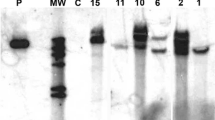Abstract
Extracts of cranberry, rich in flavonols and proanthocyanins, inactivated β-glucuronidase (GUS) in assays using either purified bacterial GUS or preparations of transgenic tobacco (Nicotiana tabacum L.) or transgenic cranberry (Vaccinium macrocarpon Ait.) expressing the gusA gene. Histochemical GUS assays produced random and generally unpredictable staining. The addition of polyvinylpolypyrrolidone (PVPP) during the preparation of transgenic cranberry leaf extracts increased the detectable GUS activity in fluorogenic assays more than 200-fold. Detectable GUS activity varied among transclones and also within a transclone depending on the developmental and physiological state of the tissue, as well as the growth environment. Use of PVPP altered the relative ranking of plants based on their total transgenic enzyme activity and resulted in different conclusions as to the effects of genotype or growth environment on transgene expression.
Similar content being viewed by others
Author information
Authors and Affiliations
Additional information
Received: 17 June 1996 / Revision received: 7 February 1997 / Accepted: 24 February 1997
Rights and permissions
About this article
Cite this article
Serres, R., McCown, B. & Zeldin, E. Detectable ,-glucuronidase activity in transgenic cranberry is affected by endogenous inhibitors and plant development. Plant Cell Reports 16, 641–646 (1997). https://doi.org/10.1007/s002990050294
Issue Date:
DOI: https://doi.org/10.1007/s002990050294




